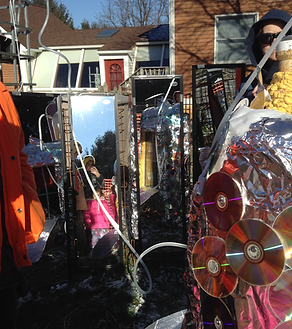

BIODIGESTION: YOU CAN COOK FOOD ON POOP AND FOOD WASTE


Each season, one Science, Technology, Engineering, and Mathematics (STEM) subject is the featured theme of the VEX IQ STEM Research Project Challenge. In this 2015-16 season, the STEM Research Project Challenge theme is Science.
Our team is doing our STEM project on biodigestion.
Question
Can you create cooking fuel out of poop and kitchen/household waste?
After researching different methods of creating biofuel, we determined that a biodigestor would be the most clean, efficient and cost-effective way to create biogas.
Research
Part of our reserach included watching and learning from this Ted Talk done by Janice Kelsey and Jody Spangler, from Solar Cities.
Our research inlcuded part of our team visiting Mrs. Kelsey's house to see the different biodigesters she has set up on her property. She also showed us slides of an inground biodigester that was installed at Mrs. Spangler's house nearby. Mrs. Kelsey is in the process of experimenting with different methods of warming the biodigestor so it will work in colder climates, such as in the colder areas in the US as well as places such as the Syrian refugee camps.



Here the digesters are painted black to keep the digester warm.
Pictured top: Janice Kelsey, Dave Leuter
Pictured Bottom: Clayton Young, Jody Spangler
Mirrors and CD's were added to reflect the day's sunlight to the digester.
Foam insulation was added to keep the warmth inside and windows were added to allow the sun's heat in during the day.

Mrs. Kelsey and Clayton in front of the model biodigestor. It's a baby girl dragon!

Making hot chocolate on a biogas stove using methane fuel from the biodigester. Mmmmmm!
A family can use their waste materials to supplement or replace some of their energy needs.
Hypothesis
Resources/Research:
Websites:
1. Green Learning: http://www.re-energy.ca/docs/biomass-energy-bg.pdf
http://www.re-energy.ca/docs/biogas-generator-cp.pdf
2. Solar Cities: http://www.solarcities.eu
3. Merriam-Webster: http://www.merriam-webster.com
4. Science Daily: https://www.sciencedaily.com/terms/fossil_fuel.htm
5. Environmental Defense Fund: https://www.edf.org/methane-other-important-greenhouse-gas
6. Wikipedia: https://en.wikipedia.org/wiki/Methane
https://en.wikipedia.org/wiki/Organic_matter
7. Science Buddies: http://www.sciencebuddies.org/science-fair-projects/project_scientific_method.shtml
Books:
1. Biofuels: http://tinyurl.com/zm7vf7h
2. Mythbusters: Confirm or Bust! Science Fair Book #2: http://tinyurl.com/hb4btgt
3. Methane Energy (Innovative Technologies): http://tinyurl.com/zc6jvyu
Procedure/Method
1. Make a small scale digester model with a scale of 55:1.
2. Determine how much cooking time a family needs per day.
3 meals/day x 1 hr cooking time/meal = 3 hours/day needed
3. Compute results of small scale x 55 to determine if the
output meets the family’s needs of 3 hours/day.
 VEXIQ STEM Project |
|---|
 On our way to collect poop! |
 Shovels ready! |
 Thanking the horses for poop! |
 Gathering Parts! |
 Drilling holes in the bucket. |
 Marking lengths. |
 Measuring |
 Cutting |
 More cutting |
 Drilling a pilot hole. |
 Drilling |
 Checking for leaks. |
 Talking to a Palestine student.We took a break to Skype with a fellow bio digester who lives in Palestine! |
 Putting plumber's caulk on seal. |
 More goop! |
 Putting in the gas pipe. |
 Putting in rocks. |
 Adding horse poop! |
 Putting on the lid. |
 After water is added. |
 It's all ready! |
 Adding active fertilizer. |
 BIOGAS! I LOVE YOU! SPIDER-MANThe hand sign means "I love you" in sign language. In biogas, the pinky represents the "inlet", the pointer represents the "gas" and the thumb represents the "outlet". We also realized it's the same sigs as SPIDERMAN! |
 Fire!!We tested the gas when we switched out the balloons, and we have biogas! |  The sealing stripThe sealing strip inside the mylar balloon was preventing gas from flowing into the balloon. So we took it out. |
|---|---|
 Final modificationWe modified the gas storage. We added a straw to keep the balloon open so the gas could flow freely. |  Ready to go!!! |
 BioGAS!!!Just after 2 days, we started collecting gas again! |  More BioGas!!!Almost full! On our way to being able to supplement or replace some of a family's energy needs! |
 Model DigesterThe model digester we made to use for our STEM presentations. The judges really enjoyed interacting and assembling the digester. |  Feeding Time!Using dog poop to make cooking gas! |
|---|---|
 ARDUINO!Installed an Arduino and temperature monitor. |  Warming the digester.Added a heated seed mat under the digester to try and warm the internal temperature. |
 Insulating!Wrapped a sheet of fiberglass around the bucket to keep the heat in. |  IT WORKED!The digester is creating a lot of gas now! The temp went from 66 to a constant 82 degrees. It's a happy baby dragon! |
 Bubbles everywhere!Look at what we woke up to on April Fool's Day! It's no joke! We have gas! Wonderful bubbles! |  Getting full!Time to find a better gas storage system! |
 Need a better system.Modifying the gas storage system. |  Final Modifications!We used a clothes vacuum bag and modified it to store the gas, including a valve to make it easier to hook up to a biogas stove. Almost time to cook a meal using poop and food waste! |
 Solar CITIES SalchichaA viable, portable, quick set up design by Solar CITIES. |  GAiN InternationalWe talked to GAiN representative, Mr. Liller, about making Salchicha kits for Syrian Refugee Camps. |
|---|---|
 Field Trip Time!Helping Mrs. Kelsey feed her "dragons". First we add food scraps to the sink. |  Puree and splatter!Next we have to chop and puree the food before adding to the digester. This makes it easier for the waste to break down. |
 Feeding the Digester |  Feeding the Digester |
 FertilizerCollecting some effluent/fertilizer to take home with us. |  Dickinson CollegeTaking a tour of the Dickinson Farm Digester with Mr. Hamburg. |
 Home BioGasA nice, clean looking home biogas kit that only takes a few hours to set up! |  Biogas!The biogas hand sign represents the 3 components - inlet, outlet and gas outlet. |
 Dickinson CollegeListened to Yair Teller, the founder of HomeBiogas speak about the importance of making this science and technology user friendly and appealing. |  Encouraging each otherMr. Teller is taking a picture of a picture of our bucket digester! |
 Clayton and Mr. Teller |
Data
STEM DATA
BUDGET
Analyze
As we analyzed the data through out the experiment, we discovered a few problems:
1. There was no gas production because our digester was outside and it was too cold to produce gas.
2. Once we brought the digester inside, we knew we were producing gas, but it was not being collected. This was due to a problem with the mylar balloon we were using.
3. Even after bringing the digester inside, gas production was steady, but slow. This was because it was still too cold for efficient gas production.
Once we fixed the balloon problem, we could then address the temperature issue. We first installed an Arduino Temperature System to monitor the digester's temperature. The initial temperature was 66 deg. F. We then brainstormed ways to heat the digester and decided to put a heated seed mat under the bucket and also to wrap the bucket in fiberglass insulation. The digester's temperature is now an average 84 deg. F.
THE RESULTS ARE IN:
Burn times for the three different gas storage systems:
1. Mylar Balloon = 48 seconds
2. Small 17 1/2” x 22 1/2” bag = 12 min. 28 sec.
3. Large 21” x 33” = 25 min. 39 sec.
Conclusion
We were able to get about 40 minutes of cooking gas
between the three different balloons/bags.
The bulk of the gas we used for cooking was collected from
April 2, 2016 through April 13, 2016, a total of 11 days.
40 minutes / 11 days = 3.6 minutes per day
3.6 minutes per day * 55 (the ratio of bucket : full size IBC) = 198 min.
198 minutes = 3 hours 18 minutes per day on a larger scale.
In addition to the numbers, we also noticed a direct relationship between the temperature and gas production. The lower the temperature, the less gas produced. The higher the temperature, the greater the gas production. We found a temperature above 80 degrees F to be a productive temperature.
Our conclusion is YES, a family can use their waste to supplement or replace some of their energy needs by using biogas. However, certain conditions, such as temperature, need to be met in order to produce a sufficient amount of methane gas.
Summary
Here is a summary of a presentation I did at the Christian Homeschool Association of Pennsylvania.
 Getting Ready to CookHooking up gas bags to stove. |  Teaching Moment |  Mylar BalloonBurning the gas that was in the balloon. |
|---|---|---|
 Burn TimeA 48 second burn time for the mylar balloon on high setting. |  Large Bag |  Burn TimeA 25 min. 14 sec. burn time on the low setting. |
 YUM!We made quesadillas and eggs! |  Small Bag |  Small BagA 12 min. 13 sec. burn time on low for the small bag. |
 IMG_1859We made hot chocolate! |  FEAST!Yes! A family CAN supplement or replace some of their energy needs by using their waste! |